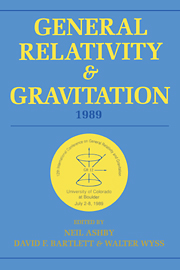 General Relativity and Gravitation, 1989
General Relativity and Gravitation, 1989 Book contents
- Frontmatter
- Contents
- Preface
- Conference committees
- Part A Classical relativity and gravitation theory
- WORKSHOPS
- Part B Relativistic astrophysics, early universe, and classical cosmology
- WORKSHOPS
- Part C Experimental gravitation and gravitational wave detection
- WORKSHOPS
- Part D Quantum gravity, superstrings, quantum cosmology
- WORKSHOPS
- D1 Theories of quantum gravity I (superstring theory)
- D2 New Hamiltonian variables
- D3 Quantum cosmology and baby universes
- D4 Quantum field theory in curved spacetime
- D5 Theories of quantum gravity II (not superstring theory)
- Part E Overviews-past, present, and future
D5 - Theories of quantum gravity II (not superstring theory)
Published online by Cambridge University Press: 05 March 2012
- Frontmatter
- Contents
- Preface
- Conference committees
- Part A Classical relativity and gravitation theory
- WORKSHOPS
- Part B Relativistic astrophysics, early universe, and classical cosmology
- WORKSHOPS
- Part C Experimental gravitation and gravitational wave detection
- WORKSHOPS
- Part D Quantum gravity, superstrings, quantum cosmology
- WORKSHOPS
- D1 Theories of quantum gravity I (superstring theory)
- D2 New Hamiltonian variables
- D3 Quantum cosmology and baby universes
- D4 Quantum field theory in curved spacetime
- D5 Theories of quantum gravity II (not superstring theory)
- Part E Overviews-past, present, and future
Summary
Introduction
Quantum theory and relativity theory, the two great revolutions of twentieth century physics, do not seem to mesh very well. Indeed the only fully consistent relativistic quantum theories seem to be linear free fields. It is not clear whether the difficulty of combining the two theories is one of principle or merely one of practice. On the most pedestrian level, the Hamiltonian formalism of classical mechanics, which is most suitable for quantizing a classical theory, requires an explicit choice of a time-like coordinate and dynamical variable adapted to this choice; relativistic theories, in contrast, treat space and time variables on essentially equal footing and are expressed most naturally in the Lagrangian formalism. Of course, for classical physical theories the two formalisms are equivalent in the sense that one can map from one to the other by means of a Legendre transformation. Thus one can, for example, follow the quantization procedure of a classical theory in the Lagrangian formalism, or demonstrate the relativistic covariance of a theory in the Hamiltonian formalism. But the exercises are decidedly awkward, and, given the ensuing difficulties which occur for non-trivial theories, one does have cause for puzzlement.
On a more fundamental level, the measurement theory for the standard interpretation of the quantum mechanical formalism requires that if an observation of a complete commuting set of local observables is performed by an observer in some finite neighborhood of a space-time point, the state of the system is reduced everywhere, including in regions well outside the forward light cone of that neighborhood.
- Type
- Chapter
- Information
- General Relativity and Gravitation, 1989Proceedings of the 12th International Conference on General Relativity and Gravitation, pp. 471 - 476Publisher: Cambridge University PressPrint publication year: 1990
